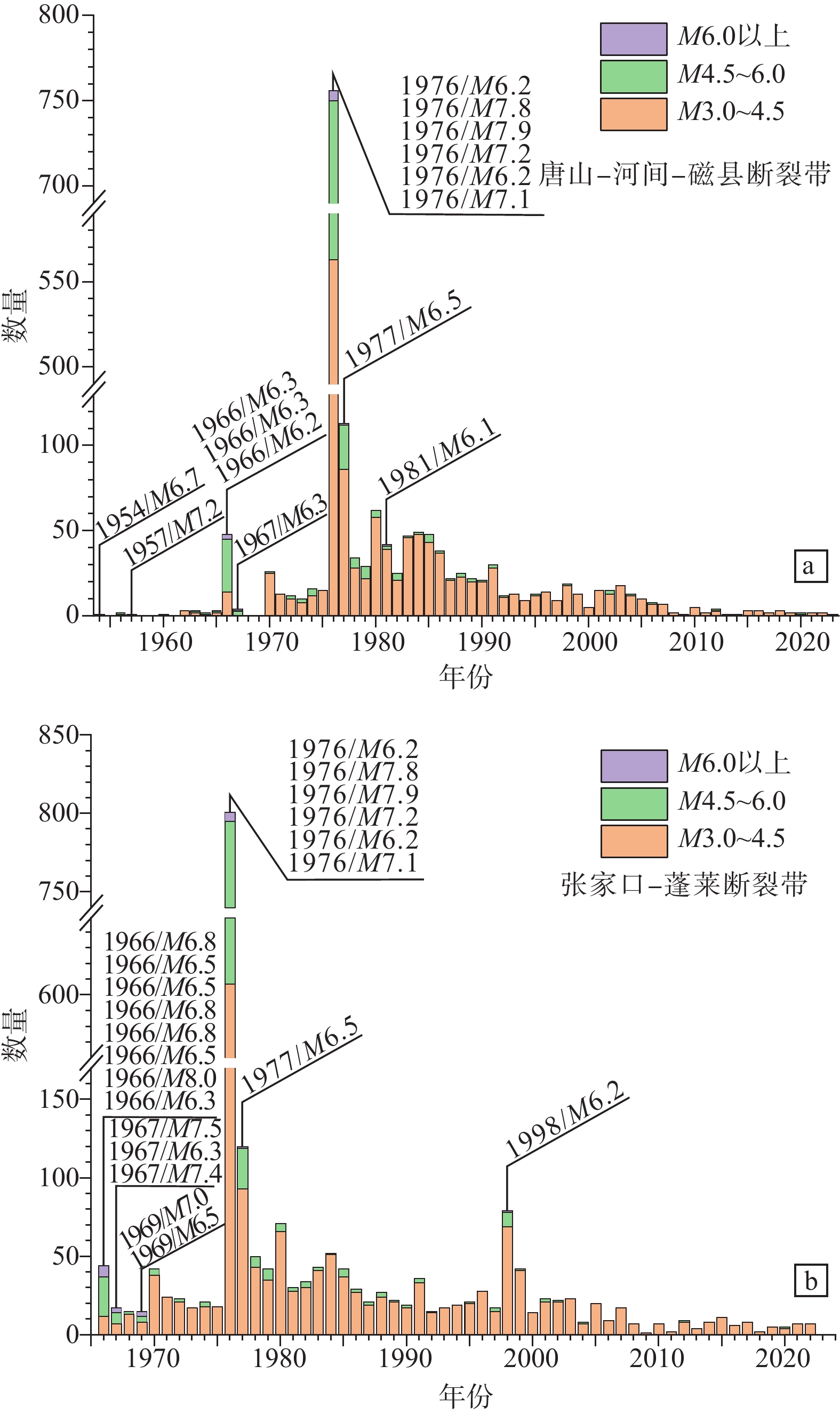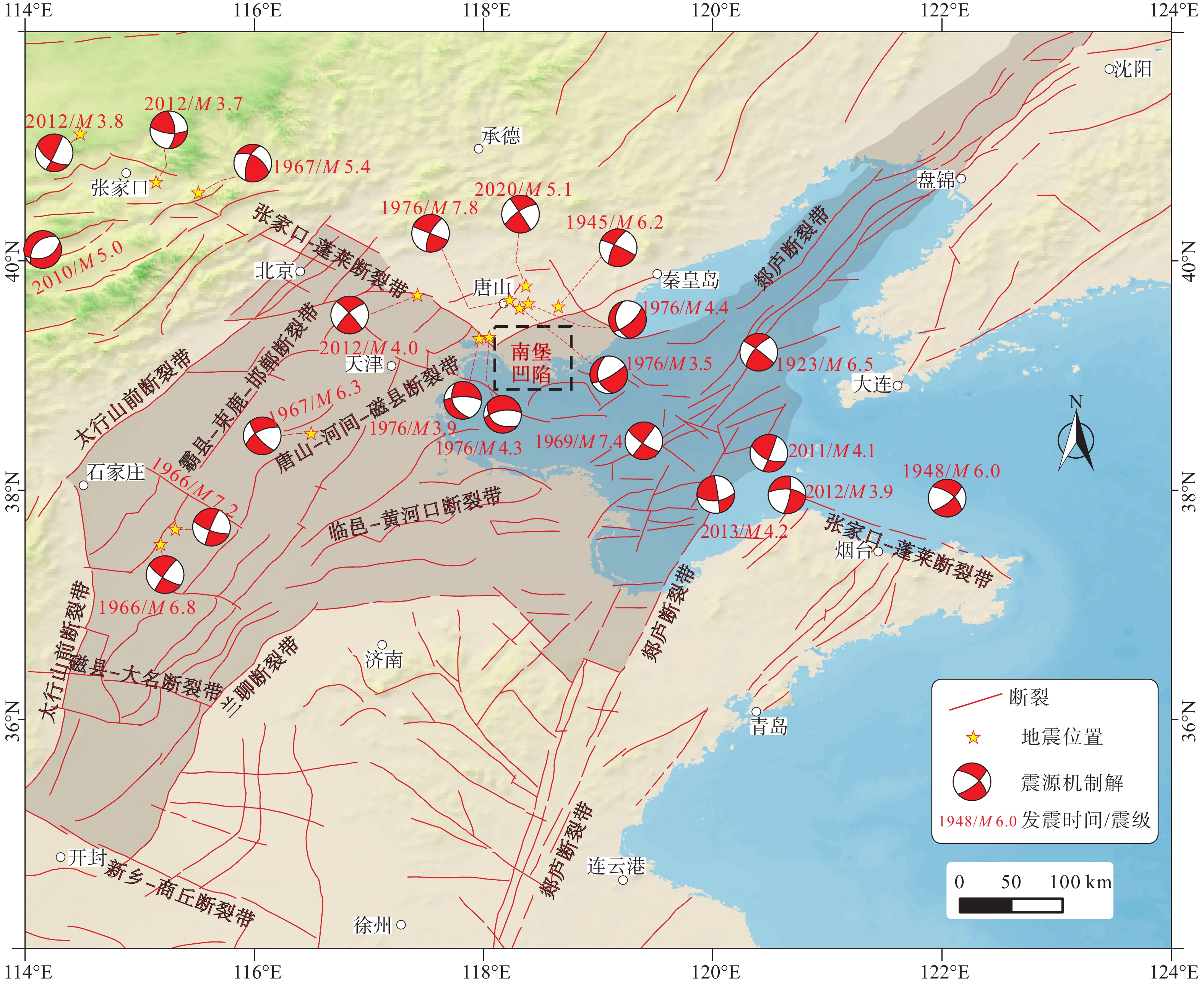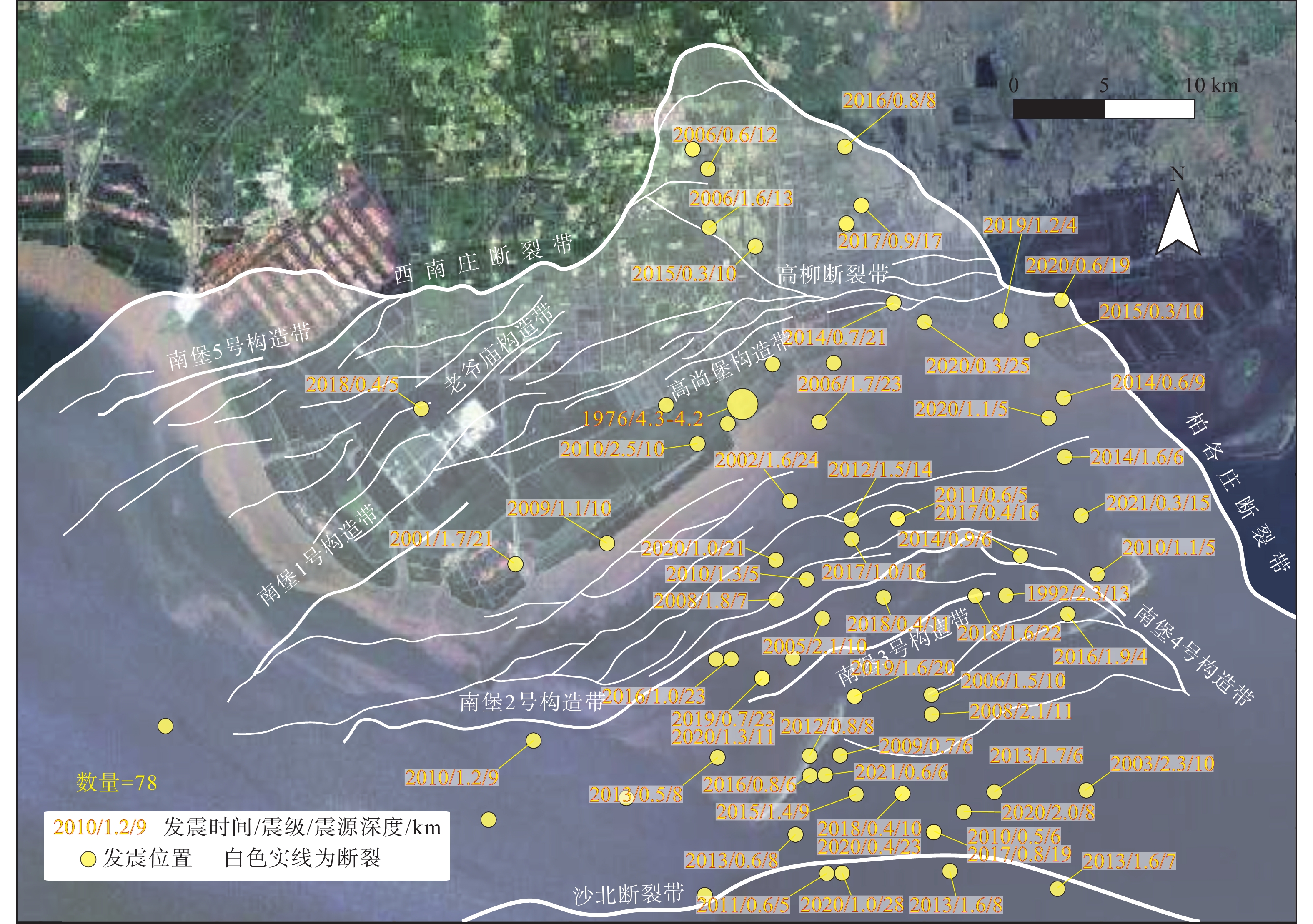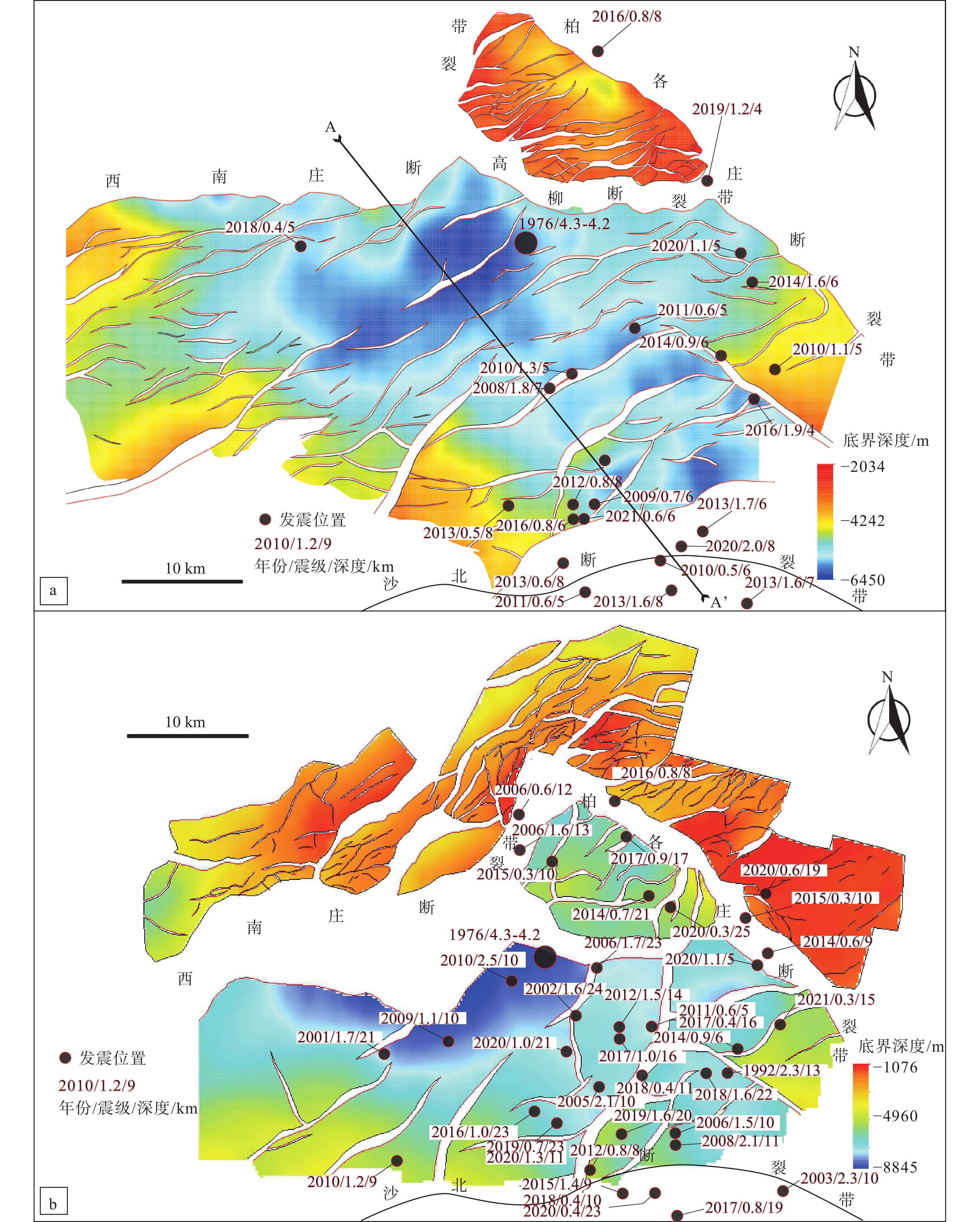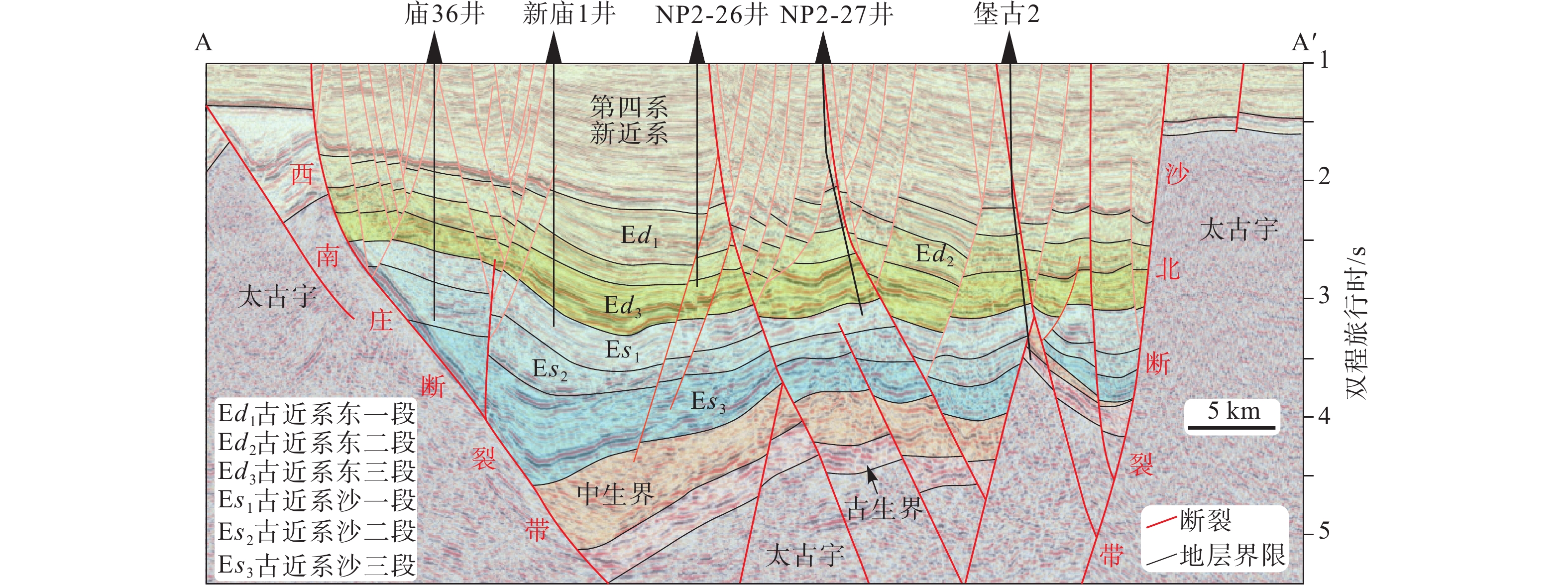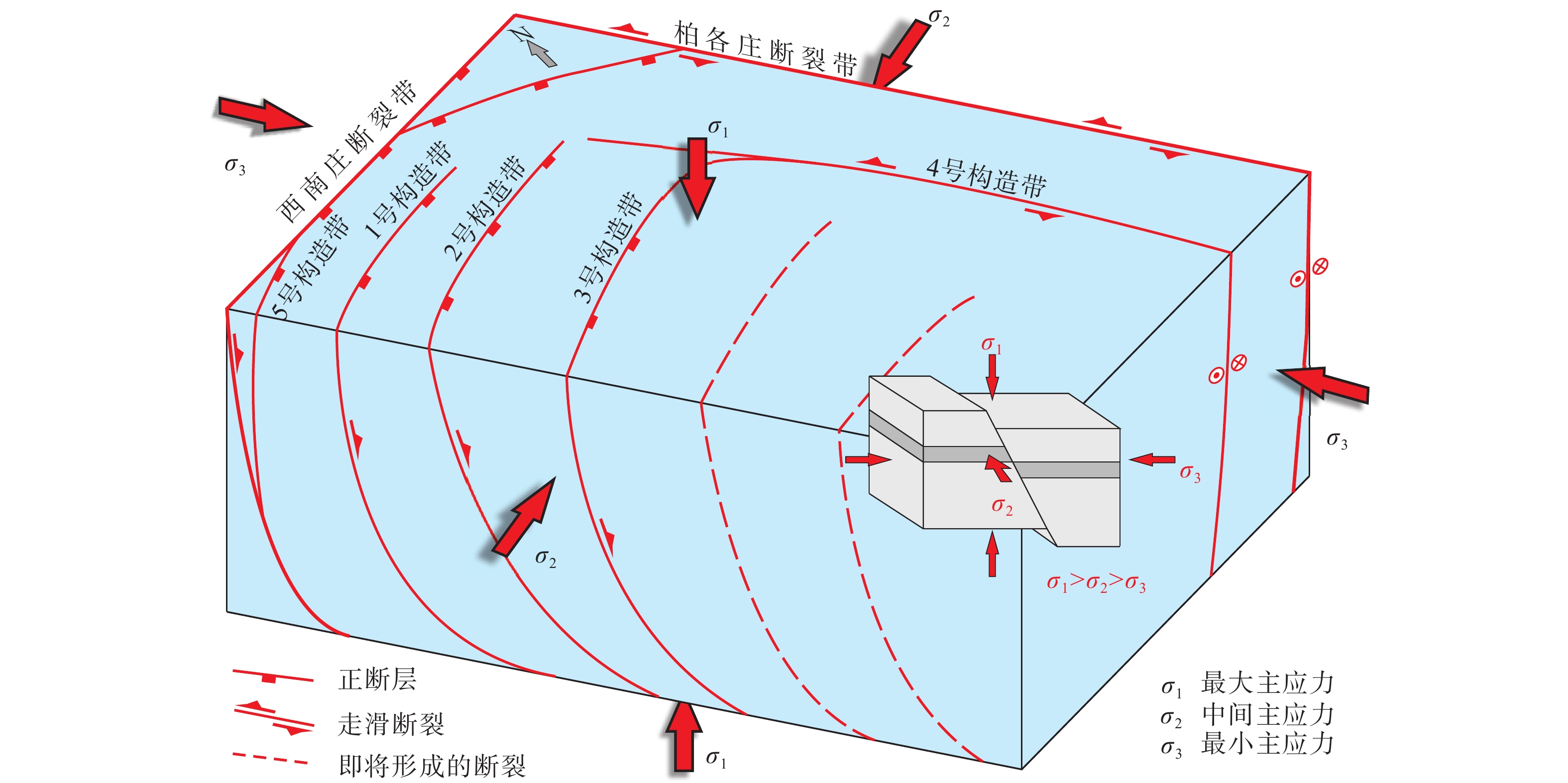Tectonic stability of the Nanpu sag: Evidence from temporal and spatial characteristics of seismic activity
-
摘要:
区域构造稳定性评价在重大工程的规划和建设中发挥着重要的参考作用。目前南堡凹陷作为中国海上储气库的建设地,其构造稳定性成为关注的热点。基于区域历史地震数据,总结了南堡凹陷及周边地震活动的时空分布规律,分析了唐山−河间−磁县断裂带和张家口−蓬莱断裂带的破裂模式,探讨了南堡凹陷地壳的构造稳定性。研究结果表明,南堡凹陷是活动构造带附近相对稳定的“安全岛”。区域上,南堡凹陷周缘积累的应力主要通过滦县−乐亭和宝坻−宁河等断裂带活动得以释放,周缘的地震活动对南堡凹陷内部的影响十分有限;而在南堡凹陷的内部,发育一个以蠕滑为主的大型伸展变形系统。根据现今的构造应力背景,南堡凹陷内的应力仅需要积累很小的量级就会诱发先存正断层的不稳定滑动,这意味着应力无法长期积累。因此,南堡凹陷内部不具备发生大地震的条件。
Abstract:Objective The evaluation of regional tectonic stability plays a crucial role in the planning and construction of major projects. Given that the Nanpu sag is the site for China's first offshore gas storage facility, its tectonic stability is naturally a focal point of concern.
Methods Based on historical seismic data for the region, this study summarizes the spatiotemporal distribution of seismic activities in the Nanpu sag and its surrounding areas. It analyzes the rupture modes of the Tangshan−Hejian−Cixian fault zone and the Zhangjiakou−Penglai fault zone, and explores the tectonic stability of the Nanpu sag.
Results The results indicate that the Nanpu sag is a relatively stable "safe island" near active tectonic zones. Regionally, stress accumulated around the periphery of the Nanpu sag is mainly released through the activity of faults such as the Luanxian−Laoting and Baodi−Ninghe faults, and the influence of the seismic activity at the periphery on the interior of the Nanpu sag is limited. Internally, a large-scale creep-dominated extensional deformation system has developed within the Nanpu sag.
Conclusion Given the current tectonic stress background, only a small magnitude of stress accumulation is required to trigger unstable sliding of pre-existing normal faults within the Nanpu sag. This suggests that stress cannot accumulate over long time scales, and thus the interior of the Nanpu sag lacks conditions for the occurrence of major earthquakes.
-
Key words:
- rupture model of fault zone /
- seismic activities /
- tectonic stability /
- Nanpu sag /
- tectonic stress
-

-
图 4 唐山−河间−磁县断裂带和张家口−蓬莱断裂带相关的震源机制解(Chen and Nábelek,1988;徐杰等,1996;张宏志等,2008;高彬等,2016;林向东等,2017;王想等,2021;Zhang et al.,2022)
Figure 4.
图 9 南堡凹陷地震剖面图(剖面位置见图8a;商琳等,2024)
Figure 9.
-
[1] CHEN Q X, 1992. An approach to assessment of regional crustal stability[J]. Quaternary Sciences, 12(4): 289-292. (in Chinese with English abstract
[2] CHEN W P, NÁBELEK J, 1988. Seismogenic strike-slip faulting and the development of the North China basin[J]. Tectonics, 7(5): 975-989. doi: 10.1029/TC007i005p00975
[3] CHEN Y K, REN F, ZHANG C F, et al., 2004. Characteristics of Late Quaternary activity of the Haihe buried fault in Tianjin municipality[J]. Seismology and Geology, 26(1): 111-121. (in Chinese with English abstract
[4] CHOI J H, EDWARDS P, KO K, et al., 2016. Definition and classification of fault damage zones: a review and a new methodological approach[J]. Earth-Science Reviews, 152: 70-87. doi: 10.1016/j.earscirev.2015.11.006
[5] COLLETTINI C, HOLDSWORTH R E, 2004. Fault zone weakening and character of slip along low-angle normal faults: insights from the Zuccale fault, Elba, Italy[J]. Journal of the Geological Society, 161(6): 1039-1051. doi: 10.1144/0016-764903-179
[6] DENG Q D, 2007. Map of active tectonics in China[M]. Beijing: Seismological Press. (in Chinese)
[7] DU D, WANG G M, 2020. Evaluation of regional crustal stability in the joint area of Beijing, Tianjin and Hebei[J]. Geological Survey and Research, 43(3): 218-223. (in Chinese with English abstract
[8] FENG C J, QI B S, WANG X S, et al., 2019. Study of fault activity risk in typical strong seismic regions in northern China by in-situ stress measurements and the influence on the Xiong’an New Area[J]. Earth Science Frontiers, 26(4): 170-190. (in Chinese with English abstract
[9] GAO B, JIA K, ZHOU S Y, 2016. Research of locations and source parameters of historical earthquakes equal and greater than M5.0 from 1900 to 1970 in North China[J]. Chinese Journal of Geophysics, 59(11): 4089-4099. (in Chinese with English abstract
[10] GAO G L, LIU W, LI C, et al., 2023. A calculation method for the storage capacity of UGS rebuilt from oil reservoirs[J]. Natural Gas Industry, 43(10): 132-140. (in Chinese with English abstract
[11] HAN G M, WANG L, XIAO D Q, et al., 2021. Magmatic hydrothermal fluid genesis of zeolite in the Paleogene Kongdian formation of Zaoyuan oilfield, Bohai Bay Basin, China[J]. Petroleum Exploration and Development, 48(5): 1101-1112. doi: 10.1016/S1876-3804(21)60094-0
[12] HAO M, LI Y H, ZHUANG W Q, 2019. Crustal movement and strain distribution in east Asia revealed by GPS observations[J]. Scientific Reports, 9(1): 16797. doi: 10.1038/s41598-019-53306-y
[13] HU H T, 2001. The theory and method of evaluation of regional crustal stability based on concept of “safe island”[J]. Journal of Geomechanics, 7(2): 97-103. (in Chinese with English abstract
[14] HU W, ZHU G, SONG L H, et al., 2013. Analysis of Quaternary activity along the Bohai segment of the Tan-Lu fault zone[J]. Earth Science Frontiers, 20(4): 137-150. (in Chinese with English abstract
[15] JING Y Q, LEI C, LIU K D, et al., 2023. Deposition environment and provenance of the Palaeogene Shahejie formation in Nanpu sag: evidences from trace and rare earth element geochemistry[J]. Bulletin of Geological Science and Technology, 42(1): 350-359. (in Chinese with English abstract
[16] KIM Y S, PEACOCK D C P, SANDERSON D J, 2004. Fault damage zones[J]. Journal of Structural Geology, 26(3): 503-517. doi: 10.1016/j.jsg.2003.08.002
[17] LI X T, XU B, HUANG D C, et al. , 1987. Theory and method of regional crustal stability[M]. Beijing: Geological Publishing House. (in Chinese)
[18] LIN X D, YUAN H Y, XU P, et al., 2017. Zonational characteristics of earthquake focal mechanism solutions in North China[J]. Chinese Journal of Geophysics, 60(12): 4589-4622. (in Chinese with English abstract
[19] LIU B J, ZHANG X K, CHEN Y, et al., 2011. Research on crustal structure and active fault in the Sanhe-Pinggu earthquake (M8.0) zone based on single-fold deep seismic reflection and shallow seismic reflection profiling[J]. Chinese Journal of Geophysics, 54(5): 1251-1259. (in Chinese with English abstract
[20] LIU L, SUN Y H, CHEN C, et al., 2022. Fault reactivation in No. 4 structural zone and its control on oil and gas accumulation in Nanpu sag, Bohai Bay Basin, China[J]. Petroleum Exploration and Development, 49(4): 824-836. doi: 10.1016/S1876-3804(22)60313-6
[21] MIN Z Q, WU G, JIANG Z X, et al. , 1995. Catalogue of Chinese historic strong earthquakes from BC 2300 to AD 1911[M]. Beijing: Seismological Press. (in Chinese)
[22] QIAO X, ZHOU Y, 2021. Geodetic imaging of shallow creep along the Xianshuihe fault and its frictional properties[J]. Earth and Planetary Science Letters, 567: 117001. doi: 10.1016/j.jpgl.2021.117001
[23] RAN R K, WANG J B, PENG S Z, et al., 1995. Palaeoeakthquake traces along the southern boundary fault of Xuanhua Basin, Hebei Province[J]. Seismology and Geology, 17(1): 44-46. (in Chinese with English abstract
[24] RAN Y K, CHEN L C, XU X W, 2001. Quantitative data about active tectonics and possible locations of strong earthquakes in the future in northwest Beijing[J]. Acta Seismologica Sinica, 23(5): 502-513. (in Chinese with English abstract
[25]



 下载:
下载:
